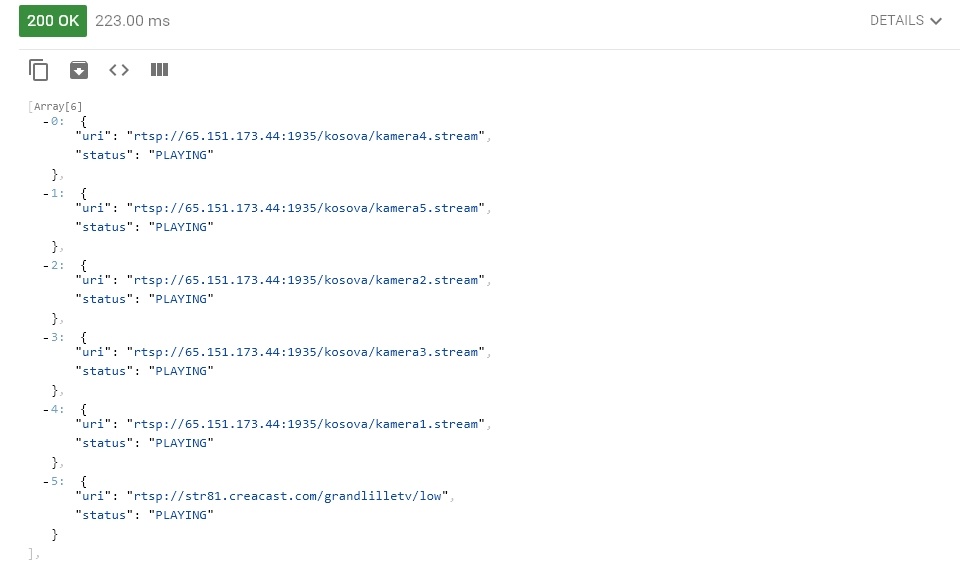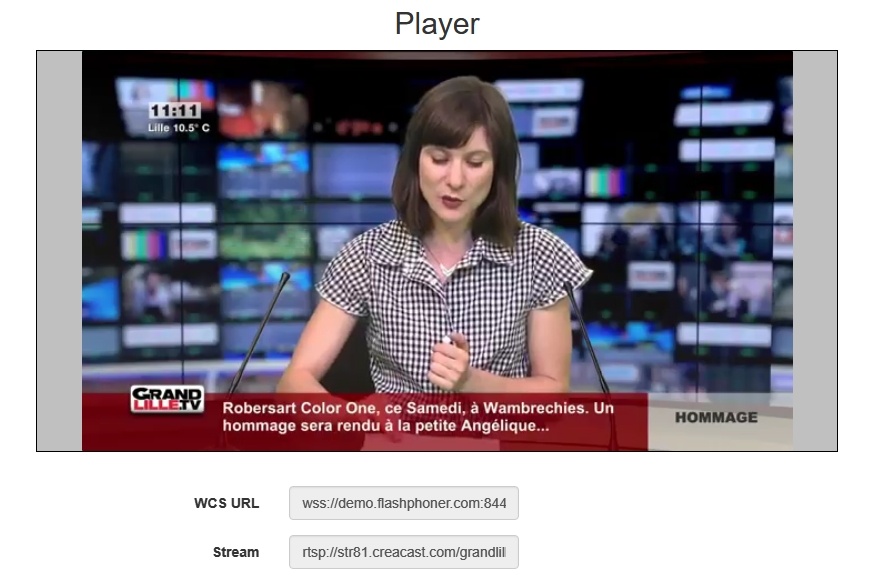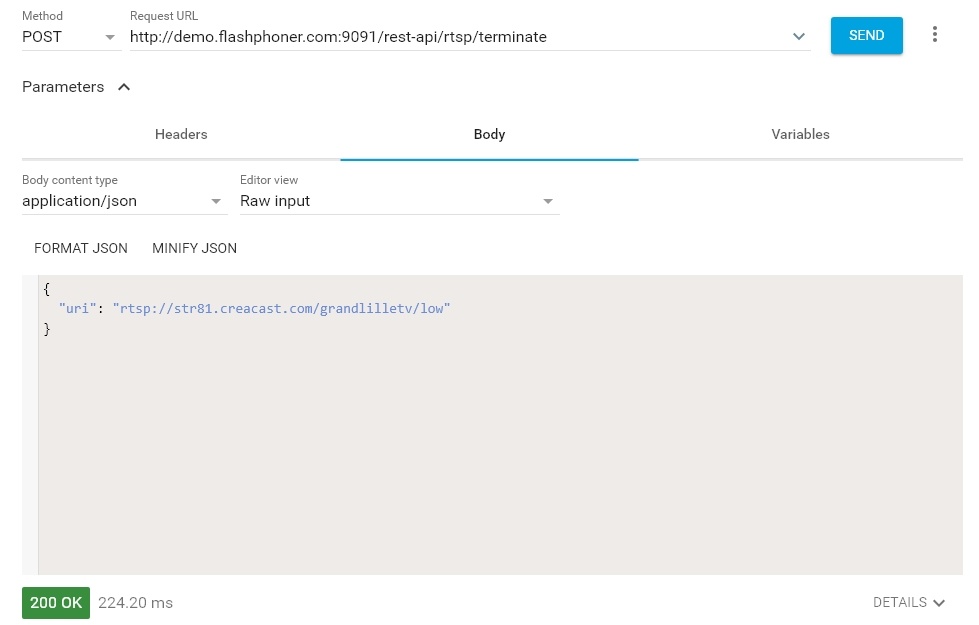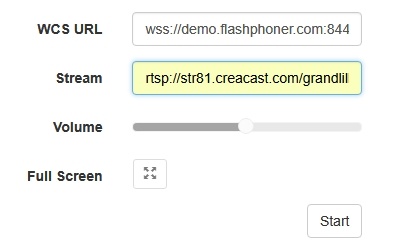Overview
A video stream is captured from an RTSP source that provides audio and video in the supported codecs. Then, the server transforms this video stream for playing in browsers and mobile devices.
RTSP sources:
- IP cameras
- Media servers
- Surveillance systems
- Conference servers
Supported codecs:
- H.264
- VP8
- AAC
- G.711
- Speex
Supported platforms and browsers
Chrome | Firefox | Safari 11 | Internet Explorer | Edge | |
|---|---|---|---|---|---|
Windows | + | + | + | + | |
Mac OS | + | + | + | ||
Android | + | + | |||
iOS | - | - | + |
To manage capturing of an RTMP stream, REST API is used.
Operation flowchart
1. The browser establishes a connection to the server via the Websocket protocol and sends the play command.
2. The server connects to the RTSP source and send the play command.
3. The RTSP source sends the RTSP stream to the server.
4. The server transforms the stream to WebRTC and gives the stream to the browser.
REST-queries
A REST-query should be HTTP/HTTPS POST request as follows:
- HTTP: http://test.flashphoner.com:9091/rest-api/rtsp/startup
- HTTPS: https://test.flashphoner.com:8888/rest-api/rtsp/startup
Where:
- test.flashphoner.com - is the address of the WCS server
- 9091 - is the standard REST / HTTP port of the WCS server
- 8888 - is the standard HTTPS port
- rest-api - is the required part of the URL
- /rtsp/startup - REST-method to use
REST-methods and response statuses
REST-method | Example of REST-query | Example of response | Response statuses | Description |
|---|---|---|---|---|
/rtsp/startup | {
"uri":"rtsp://myserver.com/live/myStream"
}
| 409 - Conflict 500 - Internal error | Pull the RTMP stream by the specified URL | |
/rtsp/find_all | {
"uri": "rtsp://myserver.com/live/myStream",
"status": "PLAYING"
}
| 200 – streams found | Find all pulled RTMP-streams | |
/rtsp/terminate | {
"uri":"rtsp://myserver.com/live/myStream"
}
| 200 - stream terminated | Terminate the pulled RTMP stream |
Parameters
Parameter name | Description | Example |
|---|---|---|
uri | URL of the RTSP stream | rtsp://myserver.com/live/myStream |
status | Current status of the stream | PLAYING |
Configuration
Sometimes, when IP camera should be connected through VPN, RTSP client should be bound to certain IP address. The option rtsp_client_address in settings file flashphoner.properties defines this address, for example:
rtsp_client_address=172.16.0.3
Quick manual on testing
Capturing a video stream from the IP camera and broadcasting it to a browser using the REST query /rtsp/startup
1. For this test we use:
- the demo server at demo.flashphoner.com;
- the Chrome browser and the REST-client to send queries to the server;
- the Player web application to play the captured stream in the browser.
2. Open the REST client. Send the /rtsp/startup query specifying the URL of the web camera in parameters:
3. Make sure the stream is captured by the server. To do this, send the /rtsp/find_all query:
4. Open the Player web app and in the "Stream" field specify the URL of the web camera and click Start. Browser starts to play the stream:
5. Send the /rtsp/terminate query specifying the URL of the web camera in parameters:
6. Stream playback will terminate displaying an error:
Capturing of a video stream from the IP camera and broadcasting it to a browser without REST queries
1. For this test we use:
- the demo server at demo.flashphoner.com;
- the Player web application to play the captured stream in the browser.
2. Open the Player web app and specify the URL of the camera in the "Stream" field:
3. Click the "Start" button. Broadcasting of the captured stream begins.
4. WebRTC internals diagrams:
Call flow
Below is the call flow when using the Player example
1. Establishing a connection to the server.
Flashphoner.createSession(); code
Flashphoner.createSession({urlServer: url}).on(SESSION_STATUS.ESTABLISHED, function(session){
setStatus(session.status());
//session connected, start playback
playStream(session);
}).on(SESSION_STATUS.DISCONNECTED, function(){
setStatus(SESSION_STATUS.DISCONNECTED);
onStopped();
}).on(SESSION_STATUS.FAILED, function(){
setStatus(SESSION_STATUS.FAILED);
onStopped();
});
2. Receiving from the server an event confirming successful connection.
ConnectionStatusEvent ESTABLISHED code
Flashphoner.createSession({urlServer: url}).on(SESSION_STATUS.ESTABLISHED, function(session){
setStatus(session.status());
//session connected, start playback
playStream(session);
}).on(SESSION_STATUS.DISCONNECTED, function(){
...
}).on(SESSION_STATUS.FAILED, function(){
...
});
3. Request to play the stream.
stream.play(); code
stream = session.createStream(options).on(STREAM_STATUS.PENDING, function(stream) {
var video = document.getElementById(stream.id());
if (!video.hasListeners) {
video.hasListeners = true;
video.addEventListener('playing', function () {
$("#preloader").hide();
});
video.addEventListener('resize', function (event) {
var streamResolution = stream.videoResolution();
if (Object.keys(streamResolution).length === 0) {
resizeVideo(event.target);
} else {
// Change aspect ratio to prevent video stretching
var ratio = streamResolution.width / streamResolution.height;
var newHeight = Math.floor(options.playWidth / ratio);
resizeVideo(event.target, options.playWidth, newHeight);
}
});
}
...
});
stream.play();
4. Request from WCS to the RTSP source to broadcast the stream.
5. Broadcasting the RTSP stream
6. Receiving from the server an event confirming successful capturing and playing of the stream.
StreamStatusEvent, статус PLAYING code
stream = session.createStream(options).on(STREAM_STATUS.PENDING, function(stream) {
...
}).on(STREAM_STATUS.PLAYING, function(stream) {
$("#preloader").show();
setStatus(stream.status());
onStarted(stream);
...
});
stream.play();
7. Sending audio- and video stream via WebRTC
8. Stopping playing the stream.
stream.stop(); code
function onStarted(stream) {
$("#playBtn").text("Stop").off('click').click(function(){
$(this).prop('disabled', true);
stream.stop();
}).prop('disabled', false);
$("#fullScreenBtn").off('click').click(function(){
stream.fullScreen();
}).prop('disabled', false);
$("#volumeControl").slider("enable");
stream.setVolume(currentVolumeValue);
}
9. Receiving from the server an event confirming successful stop of the stream playback.
StreamStatusEvent, статус STOPPED code
stream = session.createStream(options).on(STREAM_STATUS.PENDING, function(stream) {
...
}).on(STREAM_STATUS.PLAYING, function(stream) {
...
}).on(STREAM_STATUS.STOPPED, function() {
setStatus(STREAM_STATUS.STOPPED);
onStopped();
}).on(STREAM_STATUS.FAILED, function(stream) {
...
}).on(STREAM_STATUS.NOT_ENOUGH_BANDWIDTH, function(stream){
...
});
stream.play();
Known issues
1. A stream containing B-frames does not play or plays with artifacts (latencies, lags)
Symptoms:
- a stream sent by the IP camera via RTSP does not play or plays with latencies or lags
- warnings in the client log:
09:32:31,238 WARN 4BitstreamNormalizer - RTMP-pool-10-thread-5 It is B-frame!
Solution: request lower resolution video from the camera to avoid using B-frames or transcode that stream.
2. Connection to the IP camera is lost on error in any track (audio or video)
Symptoms: connection to the IP camera is lost if one of tracks returns error 4**.
Solution: this behavior is enabled by default. However if one-time errors are not critical and should not terminate broadcasting, in the flashphoner.properties files set
rtsp_fail_on_error_track=false rtp_force_synchronization=true









